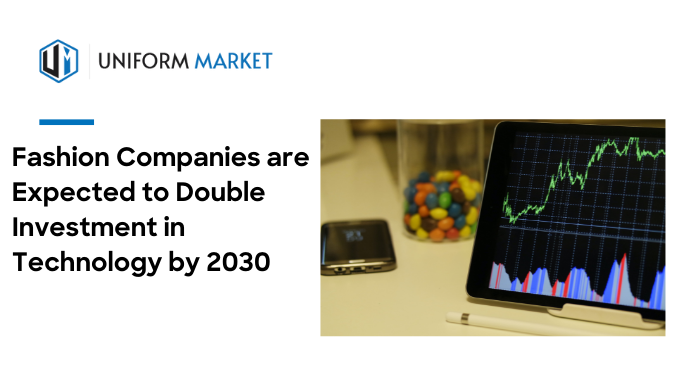McKinsey & Company, a management consulting firm, presented its state of fashion technology study in the month of May. For years, fashion has heeded the call of technology—and the industry’s future appears to be even more digital, with fashion companies aiming to double their tech spending by 2030 to stay competitive.
According to McKinsey’s State of Fashion Technology Report 2022, fashion companies invested 1.6-1.8 percent of their revenue in technology in 2021, and by 2030, that figure is expected to rise to 3-3.5 percent. Artificial intelligence (AI)-generated speech could power more than half of human interactions with computers by 2024.
Many people believe that technology may give them a competitive advantage, both in customer-facing activities (where companies have traditionally focused) and, increasingly, in operations. Robotics, advanced analytics, and in-store applications, for example, could assist streamline processes and support sustainability while still providing an amazing consumer experience (exhibit).
”Fashion companies are expected to double investment in technology by 2030 to keep up with the digital natives and to create a competitive advantage’’

As technology accelerates, fashion companies have an opportunity to serve customers better while also creating a more efficient, responsive, and responsible business
People spent slightly under four hours on their phones on average in 2021, including around two and a half hours looking through social media.
According to the survey, 48% of fashion clients who switched to online-shopping channels in 2021 cited pandemic as the reason, 27% highlighted convenience, and 11% cited product availability and promotions.
Cloud or edge computing might process more than three-quarters of enterprise-generated data by 2024. This provides a more adaptable and scalable framework for brands to construct their IT services.
More than 80% of the worldwide population is predicted to have access to 5G networks by 2030, allowing for quicker connectivity and data transfer between Internet of Things devices, among other things.
”As they move to 2025, more than 60% of fashion executives predict that integrating digital processes across their enterprises would be one of their top five areas for digitization.’’
McKinsey analysis shows that fashion companies that now embed AI into their businesses models could see a 118 per cent cumulative increase in cash flow by 2030. Conversely, those that are slower to invest in digital technology will lag behind—and could see a 23 per cent relative decline.
Over the next three years, potential key areas in which fashion executives could make digital investments are personalisation, store technologies and end-to-end value chain management. These areas in which digital can make a real difference to performance, the report said.
McKinsey and the Business of Fashion have identified five key themes that could help the industry address some pressing challenges, as well as unlock potential opportunities:
Metaverse reality check.
Although the marketing value of digital fashion and nonfungible tokens (NFTs) is already evident, fashion firms will need to differentiate the real prospects from the hype in order to develop long-term revenue streams from the metaverse.
Hyper personalization
To improve how they tailor and personalise their consumer relationships, brands have access to a growing arsenal of customization tools and technology. Executives now have the chance to use big data and artificial intelligence to deliver personalised experiences that foster long-term loyalty.
Connected stores
The unstoppable expansion of e-commerce has prompted fashion brands to reconsider their physical storefronts. Using in-store mobile apps to improve the in-store experience and micro fulfilment technology to use the store for the quick-commerce era, fashion executives may address consumer pain issues.
End-to-end upgrade
Key elements of the fashion value chain have been altered by digital tools and analytics, but these advancements are often compartmentalised within enterprises, limiting the possibility for cross-functional benefits. To become more efficient and successful, brands should integrate their value chains from beginning to end.
Traceability first
Fashion businesses will be able to reach far into their supply chains with traceability systems powered by traceability software and big data, which will be a crucial enabler for sustainability road maps.
For many fashion brands, highly personalized customer experiences are a cornerstone of their digital businesses. Their customers expect nothing less. Advancements in AI, analytics, and cloud computing mean that businesses have the tools to work with all types of data across channels in real time. This could support a move to hyper personalization, in which technology could help search-based e-commerce transform into individualized discovery of products and styles. This may enable customers to routinely access curated websites and marketplaces, from landing pages to payments. To make that vision a reality, decision makers may need to optimize their data and analytics capabilities and roll them out at scale.
Mckinsey sees brands increasing their focus on traceability through their supply chains, helping them address demands from regulators, investors, and customers for greater transparency. As they aim to cut emissions and meet their environmental, social, and governance (ESG) targets, brands could benefit from a common data language to enable comparability, as well as new labelling standards and tracking software.
About Mckinsey and Company:
McKinsey & Company is a global management consulting firm that serves leading businesses, governments, non-governmental organizations, and not-for-profits. They help clients make lasting improvements to their performance and realize their most important goals. Over nearly a century, they have built a firm uniquely equipped to this task.
They serve clients at every level of their organization, in whatever capacity they can be most useful, whether as a trusted advisor to top management or as a hands-on coach for front line employees. For every engagement, they assemble a team with the most appropriate experience and expertise.
Also read: Kearney Reshoring Index Dips, but Good News Ahead













